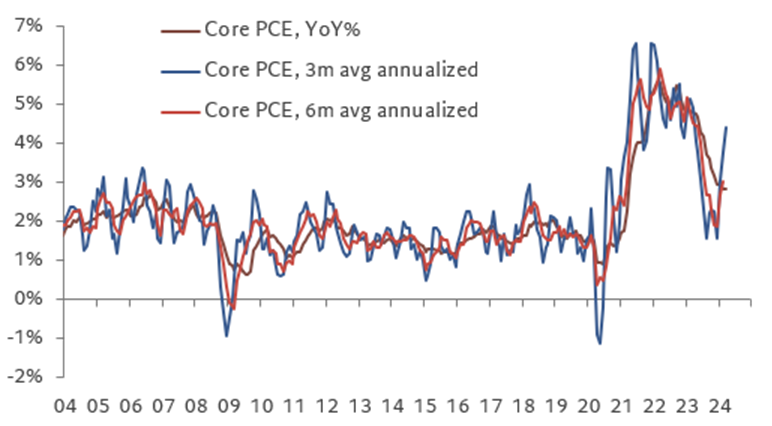Below you will find a new commentary by Xiao Cui, Senior Economist Pictet Wealth Management, on the FED.
We expect a hawkish hold at the FOMC this week. Chair Powell is likely to note it would take longer than expected to achieve confidence needed to cut rates and recent economic data suggest later and fewer cuts. We expect an announcement of QT tapering at this week’s meeting (June at the latest), a reduction in the pace of balance-sheet rundown where the redemption cap on Treasuries declines by half to $30bn per month and the non-binding cap on MBS remains unchanged at $35bn.
There is no updated dot plot or economic projections, so the press conference takes center stage. Recent firmer-than-expected inflation readings and subsequent upward revisions likely eroded the Fed’s confidence that inflation can return more sustainably to target over time, and the Fed likely needs to see several months of an inflation slowdown before attempting rate cuts. With a solid labor market, there is no urgency to cut rates. We do not expect Powell to defend the March dot plot median of three rate cuts this year, and he’s likely to repeat that policy can remain on hold while the evolving data guide the rate path.
Powell will likely be asked about potential rate hikes, and we expect the Chair to note policy is likely sufficiently restrictive and well positioned to handle risks – if inflation is more persistent, the Fed can hold rates high for as long as needed (not hiking). If labor market unexpectedly weakens, the Fed can ease. We expect the Chair’s baseline outlook continues to be that inflation will decline further. A more open-minded response or an acknowledgement to a potential rate hike would be a hawkish risk. We continue to view the bar to a resumed rate hike to be high. It would likely take a reacceleration in inflation, not just inflation stalling out at a higher level, to prompt the FOMC to reconsider hikes.
We expect the policy statement to remain largely unchanged, but risks are to the hawkish side. The forward guidance should remain with an easing bias, noting that “The Committee does not expect it will be appropriate to reduce the target range until it has gained greater confidence that inflation is moving sustainably toward 2 percent”. One marginally hawkish change would be if the FOMC removes the word “greater” to signal that confidence is lacking. The description that “inflation has eased over the past year” remains relevant, but the committee could opt to show a more hawkish interpretation by mentioning recent momentum (see chart below).
Chair Powell will likely be asked about Fed independence and his plan in a Trump second term. Recent reports suggest Trump’s advisors are drawing up plans to make the Fed more political and there had been repeated calls to fire Powell during Trump’s presidency. The president lacks the authority to fire the Fed Chair due to policy differences, and the Chair can only be fired “for cause”. Any nomination of a new Fed chair would need Senate approval, a chamber historically known for supporting Fed independence from political influence, whether Republican or Democrat-controlled. When asked about whether he would resign as Fed chair in 2019, Powell replied “It doesn’t occur to me in the slightest that there would be any situation in which I would not complete my term other than dying.”
We expect gradually slowing inflation and a modest slowdown in demand (to a still solid pace) to get the Fed to ease twice this year, but risks are skewed towards later and fewer cuts this year and next. Solid domestic demand and upward revisions to inflation suggest the Fed will take an even more patient approach to policy adjustment.





